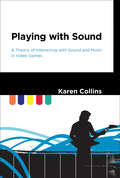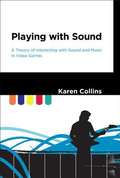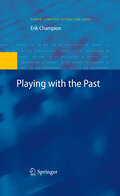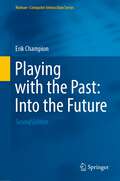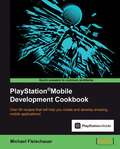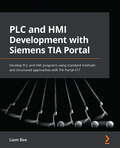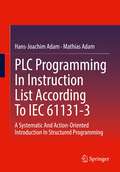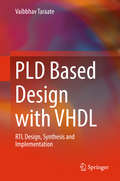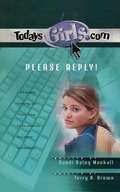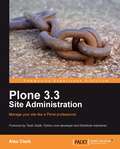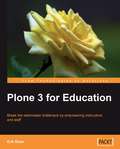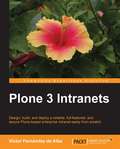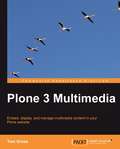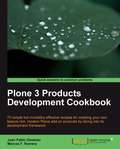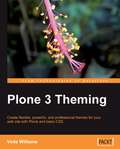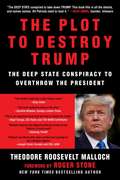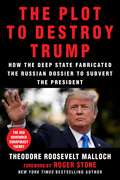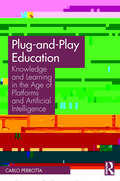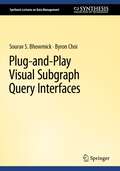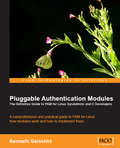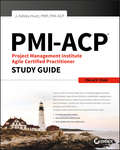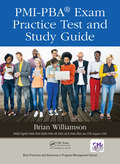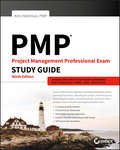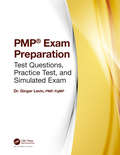- Table View
- List View
Playing with Sound: A Theory of Interacting with Sound and Music in Video Games
by Karen CollinsAn examination of the player's experience of sound in video games and the many ways that players interact with the sonic elements in games. In Playing with Sound, Karen Collins examines video game sound from the player's perspective. She explores the many ways that players interact with a game's sonic aspects—which include not only music but also sound effects, ambient sound, dialogue, and interface sounds—both within and outside of the game. She investigates the ways that meaning is found, embodied, created, evoked, hacked, remixed, negotiated, and renegotiated by players in the space of interactive sound in games.Drawing on disciplines that range from film studies and philosophy to psychology and computer science, Collins develops a theory of interactive sound experience that distinguishes between interacting with sound and simply listening without interacting. Her conceptual approach combines practice theory (which focuses on productive and consumptive practices around media) and embodied cognition (which holds that our understanding of the world is shaped by our physical interaction with it).Collins investigates the multimodal experience of sound, image, and touch in games; the role of interactive sound in creating an emotional experience through immersion and identification with the game character; the ways in which sound acts as a mediator for a variety of performative activities; and embodied interactions with sound beyond the game, including machinima, chip-tunes, circuit bending, and other practices that use elements from games in sonic performances.
Playing with Sound: A Theory of Interacting with Sound and Music in Video Games
by Karen CollinsKaren Collins examines video game sound from the player's perspective. She explores the many ways that players interact with a game's sonic aspects -- which include not only music but also sound effects, ambient sound, dialogue, and interface sounds -- both within and outside of the game. She investigates the ways that meaning is found, embodied, created, evoked, hacked, remixed, negotiated, and renegotiated by players in the space of interactive sound in games. Drawing on disciplines that range from film studies and philosophy to psychology and computer science, Collins develops a theory of interactive sound experience that distinguishes between interacting with sound and simply listening without interacting. Her conceptual approach combines practice theory (which focuses on productive and consumptive practices around media) and embodied cognition (which holds that our understanding of the world is shaped by our physical interaction with it). Collins investigates the multimodal experience of sound, image, and touch in games; the role of interactive sound in creating an emotional experience through immersion and identification with the game character; the ways in which sound acts as a mediator for a variety of performative activities; and embodied interactions with sound beyond the game, including machinima, chip-tunes, circuit bending, and other practices that use elements from games in sonic performances.
Playing with the Past
by Erik ChampionHow can we increase awareness and understanding of other cultures using interactive digital visualizations of past civilizations? In order to answer the above question, this book first examines the needs and requirements of virtual travelers and virtual tourists. Is there a market for virtual travel? Erik Champion examines the overall success of current virtual environments, especially the phenomenon of computer gaming. Why are computer games and simulations so much more successful than other types of virtual environments? Arguments that virtual environments are impeded by technological constraints or by a paucity of evaluation studies can only be partially correct, for computer games and simulations are also virtual environments. Many of the underlying issues are caused by a lack of engagement with the philosophical underpinnings of culture, presence and inhabitation, and there are few exemplars that engage the public with history and heritage using interactive media in a meaningful and relevant manner. The intention of Playing With the Past is to help designers and critics understand the issues involved in creating virtual environments that promote and disseminate historical learning and cultural heritage through a close study of the interactive design principles at work behind both real and virtual places. Topics discussed include the design of virtual environments, and especially virtual heritage environments, virtual place-making, cultural presence, the pros and cons of game-style interaction, augmented reality projects, and appropriate evaluation methods. Virtual heritage environments discussed in the book include projects from Antarctica, Australia, Mexico, Malta, Egypt, Babylon, the Netherlands, Cambodia, and India.
Playing with the Past: Into the Future (Human–Computer Interaction Series)
by Erik ChampionSince the turn of this century (and even earlier), a plethora of projects have arisen to promise us bold new interactive adventures and immersive travel into the past with digital environments (using mixed, virtual or augmented reality, as well as computer games). In Playing with the Past: Into the Future Erik Champion surveys past attempts to communicate history and heritage through virtual environments and suggests new technology and creative ideas for more engaging and educational games and virtual learning environments.This second edition builds on and updates the first edition with new game discussions, surveys, design frameworks, and theories on how cultural heritage could be experienced in digital worlds, via museums, mobile phones, or the Metaverse. Recent games and learning environments are reviewed, with provocative discussion of new and emerging promises and challenges.
PlayStation®Mobile Development Cookbook
by Michael FleischauerWritten as a series of engaging and practical recipes, this essential Cookbook has been meticulously designed and reviewed in order to provide you with the ultimate reference for PlayStation®Mobile development.If you've got some prior experience with C# and want to create awesome projects for the PlayStation®Vita and PlayStationTMCertified devices, then this book is for you.
PLC and HMI Development with Siemens TIA Portal: Develop PLC and HMI programs using standard methods and structured approaches with TIA Portal V17
by Liam BeeBecome well-versed with the tools available in the Siemens TIA toolbox and write PLC and HMI code effectivelyKey FeaturesFind out how to use TIA Portal effectively to boost your productivityLearn about a structured design pattern and understand why it is so powerful when implemented correctlyDiscover efficient project management and design practicesBook DescriptionWith automation requirements on the rise, Siemens' TIA Portal development environment is almost a necessity for any automation engineer. The Totally Integrated Automation (TIA) environment helps seamlessly integrate all things automation, from PLC hardware and software design to HMI development. This book helps you understand the tools available in the TIA toolbox and shows you how to write code effectively.The book begins by introducing you to the TIA environment, covering the layout and tools available. Once you've got to grips with the environment, you'll find out how to create hardware to write programs against, including adding IO modules and assigning memory for input and output. Next, you'll develop logic in all of the languages that TIA Portal offers, such as Ladder, Function Block Diagram, and Structured Text (SCL) (note that Statement List is not covered as a deprecated language), as well as the newest language, Cause and Effect (CEM). You'll also discover how to store standard code in libraries, creating a version control system that is easy to manage and aids standard design. Finally, following the PLC design chapters, you'll learn how to develop HMI applications in TIA Portal's latest unified hardware.By the end of the book, you'll be well equipped to use all of the features that TIA Portal V17 offers.What you will learnSet up a Siemens Environment with TIA PortalFind out how to structure a projectCarry out the simulation of a project, enhancing this further with structureDevelop HMI screens that interact with PLC dataMake the best use of all available languagesLeverage TIA Portal's tools to manage the deployment and modification of projectsWho this book is forThis TIA Portal book is for anybody looking to learn PLC/HMI development using the latest Siemens development platform. Industrial software engineers, PLC engineers, automation engineers, and electricians will be able to advance their skill set with this guide. A basic understanding of PLC principles such as PLC data types and basic objects such as function blocks and functions is necessary to get started.
PLC Programming In Instruction List According To IEC 61131-3: A Systematic And Action-Oriented Introduction In Structured Programming
by Hans-Joachim Adam Mathias AdamThis textbook and exercise book provides a solid basic knowledge and comprehensive practical skills in dealing with PLC programming. Numerous exercises help to deepen the material. With the accompanying simulation software and sample solutions, the acquired knowledge can be applied immediately. The software can be downloaded via the Internet. The knowledge of number systems and digital technology conveyed in the book is an important prerequisite for skilful and clever PLC programming. The programming language used, "Instruction list according to IEC 61131-3", provides the best insights into the functioning of a PLC. The didactically prepared programming examples for switching networks, signal memories, time functions, counters, function blocks and functions, program structures, sequence controls, data types and much more enable systematic learning of programming. The 5th, corrected edition experiences an expansion of the exercises with a didactically prepared project for the control of a mountain railway. The associated simulation software "PLC-lite" enables the realisation of controls for the mountain railway and the "realistic" representation of the cableway movements on the screen.
PLD Based Design with VHDL
by Vaibbhav TaraateThis book covers basic fundamentals of logic design and advanced RTL design concepts using VHDL. The book is organized to describe both simple and complex RTL design scenarios using VHDL. It gives practical information on the issues in ASIC prototyping using FPGAs, design challenges and how to overcome practical issues and concerns. It describes how to write an efficient RTL code using VHDL and how to improve the design performance. The design guidelines by using VHDL are also explained with the practical examples in this book. The book also covers the ALTERA and XILINX FPGA architecture and the design flow for the PLDs. The contents of this book will be useful to students, researchers, and professionals working in hardware design and optimization. The book can also be used as a text for graduate and professional development courses.
Please Reply!
by Dandi Daley MackallAs fifteen-year-old Jamie becomes involved in the swim team and Special Olympics coaching, as part of her effort to fit in and be normal, she tries to remember to talk to God.
Plone 3.3 Site Administration
by Alex ClarkThis book is a step-by-step tutorial guide, explaining many common and fundamentally important Plone site administration tasks. This book is designed for site administrators, webmasters, or content editors managing a site with Plone. These users will not be new to Plone itself, but they will be new to the site administration tasks. The reader is also expected to know basic Python programming. This book caters to these users, and builds their confidence by helping them to get their Plone sites up, running, and customized with minimal peripheral knowledge.
Plone 3 for Education
by Erik RoseThis book is written especially for time-constrained web teams. Every chapter is hands-on from start to finish, focusing on getting a value-adding site up fast. Necessary theory and tips on best practices are interspersed with the step-by-step instructions, broken out into sidebars so it informs your progress without impeding it. Also, every chapter is independent, dealing with a specific use case--for example, publishing video, creating forms, or representing assignment schedules and syllabi--so you can skip straight to what you need. Most chapters require no programming at all. The few where we dig deeper (for example, to build our own plug-in products) are replete with working code samples and explanations of what's going on. A rudimentary knowledge of the Python programming language is helpful in these but is not essential. Plone 3 for Education is for the makers of school web sites, from primary to university, from e-learning to public-facing, from tech-savvy teachers to seasoned software developers. A user-level familiarity with Plone is the only prerequisite; everything else is baked in.
Plone 3 Intranets
by Victor Fernandez AlbaThis is a step-by-step guide, from installing your first Plone instance to deploying your intranet. Each chapter will show you an essential aspect that your intranet should have. However, each chapter is isolated enough to serve as a reference manual for later use. The book is packed with examples and useful screenshots for easy learning. This book is for anyone who needs to build an intranet with no limits on capabilities or features. Even if you don't have previous CMS experience or programming skills, this book is for you. Targeted at beginners with no previous experience with Plone, this book will teach you step by step and at the end you should have a full-featured, reliable, and secure intranet.
Plone 3 Multimedia
by Tom GrossThis book is written in a tutorial style where you work through examples that describe how you can create multimedia applications using Plone and integrate your existing multimedia resources into your website. It also tells you how to use multimedia effectively giving many ideas and best practices. This book is for Plone integrators who want to extend the core of Plone with multimedia features. It gives no introduction to Plone and readers should know how to set up a Plone site using a buildout. The book can be read and understood well without being a Python developer, though some examples have Python code included.
Plone 3 Products Development Cookbook
by Juan Pablo GimenezThe examples in this book follow a sample project creating a digital newspaper website to meet the requirements of a fictional customer who wants to place commercial advertisements all over the site. The whole book is a comprehensive collection of recipes that elaborate a series of well known use cases. You will find an organized step-by-step procedure to accomplish each task followed by detailed explanations to better understand how and why each topic was undertaken, and many links to online references and other related sections in the book that can supplement the subject in question. You can read the whole book or just pick the recipes that are relevant for you; where necessary, cross references will help you understand the recipes even if you do not read them in sequential order. This book is for programmers who have some knowledge of Python, Plone, and Zope. If you want to develop feature-rich add-on products in Plone, this book is for you. It is aimed at the development of backend features, so you need not have other web-related skills such as HTML, CSS, or JavaScript.
Plone 3 Theming
by Veda WilliamsThis book provides a holistic look at theming Plone sites as well as step-by-step instructions on how to create Plone themes. The book first briefly introduces the concepts and necessary tools and then moves on to describing the concepts needed for customizing templates in Plone. It also provides handy tips and tricks along the way to simplify the theming process. This book is targeted at professional web designers working with Plone who want to create their own unique look and feel for a Plone web site.
The Plot to Destroy Trump: The Deep State Conspiracy to Overthrow the President
by Theodore Roosevelt Malloch“The DEEP STATE conspired to take down TRUMP. This book fills in all the details, and names names. All Patriots need to read it.” Alex Jones, founder, Infowars With a new afterword, updated from its hardcover edition, The Plot to Destroy Trump exposes the deep state conspiracy to discredit and even depose the legitimately elected President Donald J. Trump with the fabricated Russian dossier, including: How the unsubstantiated accusations of collusion began with former MI6 agent Christopher Steele, Fusion GPS, and the Democratic National Convention on behalf of Hillary Clinton The opportunistic role played by Russia’s FSB and former KGB agents, according to Putin’s strategy to create chaos in the West Wikileaks, along with Fake News Award–winner CNN, BuzzFeed, and the other liberal media that all played a part in pushing the information to the American people The compromised CIA and FBI personnel who took the dossier and ran with it, despite knowing it was unverified The roles that George Papadopoulos, Carter Page, Bruce and Nellie Ohr, Paul Singer, Paul Manafort, and the Podesta brothers played?or did not play?in the conspiracy against the president How does all this tie together? And what does it mean for Trump’s presidency and American democracy? Ted Malloch names the players, connects the dots, and explains who was behind the plot to create a red November. With a foreword by New York Times bestseller and Trump confidant Roger Stone, The Plot to Destroy Trump uncovers the biggest political scandal since Watergate.
The Plot to Destroy Trump: How the Deep State Fabricated the Russian Dossier to Subvert the President
by Theodore Roosevelt Malloch Roger Stone“The DEEP STATE conspired to take down TRUMP. This book fills in all the details, and names names. All Patriots need to read it.” ?Alex Jones, founder, InfowarsThe Plot to Destroy Trump exposes the deep state conspiracy to discredit and even depose the legitimately elected President Donald J. Trump with the fabricated Russian dossier, including: How the unsubstantiated accusations of collusion began with former MI6 agent Christopher Steele, Fusion GPS, and the Democratic National Convention on behalf of Hillary Clinton The opportunistic role played by Russia’s FSB and former KGB agents, according to Putin’s strategy to create chaos in the West Wikileaks, along with Fake News Award–winner CNN, BuzzFeed, and the other liberal media that all played a part in pushing the information to the American people The compromised CIA and FBI personnel who took the dossier and ran with it, despite knowing it was unverified The roles that George Papadopoulos, Carter Page, Bruce and Nellie Ohr, Paul Singer, Paul Manafort, and the Podesta brothers played?or did not play?in the conspiracy against the presidentHow does all this tie together? And what does it mean for Trump’s presidency and American democracy? Ted Malloch names the players, connects the dots, and explains who was behind the plot to create a red November. With a foreword by New York Times bestseller and Trump confidant Roger Stone, The Plot to Destroy Trump uncovers the biggest political scandal since Watergate.
Plug-and-Play Education: Knowledge and Learning in the Age of Platforms and Artificial Intelligence
by Carlo PerrottaPlug-and-Play Education: Knowledge and Learning in the Age of Platforms and Artificial Intelligence documents and critiques how the education sector is changing with the advancement of ubiquitous edtech platforms and automation. As programmability and computation reengineer institutions towards efficiency and prediction, the perpetual collection of and access to digital data is creating complex opportunities and concerns. Drawing from research into secondary and higher education settings, this book examines the influence of digital “infrastructuring”, the automation of teaching and learning, and the very purpose of education in a context of growing platformisation and artificial intelligence integration. These theoretical, practical, and policy-oriented insights will offer educational technologists, designers, researchers, and policymakers a more inclusive, diverse, and open-ended perspective on the design and implementation of learning technologies.
Plug-and-Play Visual Subgraph Query Interfaces (Synthesis Lectures on Data Management)
by Sourav S. Bhowmick Byron ChoiThis book details recent developments in the emerging area of plug-and-play (PnP) visual subgraph query interfaces (VQI). These PnP interfaces are grounded in the principles of human-computer interaction (HCI) and cognitive psychology to address long-standing limitations to bottom-up search capabilities in graph databases using traditional graph query languages, which often require domain experts and specialist programmers. This book explains how PnP interfaces go against the traditional mantra of VQI construction by taking a data-driven approach and giving end users the freedom to easily and quickly construct and maintain a VQI for any data sources without resorting to coding. The book walks readers through the intuitive PnP interface that uses templates where the underlying graph repository represents the socket and user-specified requirements represent the plug. Hence, a PnP interface enables an end user to change the socket (i.e., graph repository) or the plug (i.e., requirements) as necessary to automatically and effortlessly generate VQIs. The book argues that such a data-driven paradigm creates several benefits, including superior support for visual subgraph query construction, significant reduction in the manual cost of constructing and maintaining a VQI for any graph data source, and portability of the interface across diverse sources and querying applications. This book provides a comprehensive introduction to the notion of PnP interfaces, compares it to its classical manual counterpart, and reviews techniques for automatic construction and maintenance of these new interfaces. In synthesizing current research on plug-and-play visual subgraph query interface management, this book gives readers a snapshot of the state of the art in this topic as well as future research directions.
Pluggable Authentication Modules: The Definitive Guide to PAM for Linux SysAdmins and C Developers
by Kenneth GeisshirtThis book provides a practical approach to UNIX/Linux authentication. The design principles are explained thoroughly, then illustrated through the examination of popular modules. It is intended as a one-stop introduction and reference to PAM. This book is for experienced system administrators and developers working with multiple Linux/UNIX servers or with both UNIX and Windows servers. It assumes a good level of admin knowledge, and that developers are competent in C development on UNIX-based systems.
PMI-ACP Project Management Institute Agile Certified Practitioner Exam Study Guide
by J. Ashley HuntThe ultimate study package for the new PMI-ACP exam The PMI-ACP Project Management Institute Agile Certified Practitioner Exam Study Guide is an all-in-one package for comprehensive exam preparation. This up-to-date guide is fully aligned with the latest version of the exam, featuring coverage of 100 percent of the exam domains. Expanded coverage of AGILE includes the basic principles, value-driven delivery, stakeholder engagement, team performance, adaptive planning, problem detection and resolution, and continuous improvement to align with the A Guide to the Project Management Body of Knowledge (PMBOK® 6th Edition) and its increased emphasis on agile, adaptive and iterative practices. In-depth discussion merges with hands-on exercises and real-world scenarios to provide a well-rounded review of essential exam concepts, while the online learning center provides an assessment test, chapter tests, a practice exam, and study aids to help you ensure complete preparation for the big day. Master 100 percent of the exam objectives, including expanded AGILE coverage Reinforce critical concepts with hands-on practice and real-world scenarios Test your knowledge with challenging chapter review questions One year of FREE access to the Sybex online test bank featuring practice tests, flashcards, a glossary, and more Project management is one of the most in-demand skills in today's job market, making more and more employers turn to AGILE methodologies to enhance delivery and results. The PMI-ACP certification shows employers that you have demonstrated mastery of essential project management skills and a practical understanding of adaptive, iterative processes; this validation puts you among the ranks of qualified project management professionals employers are desperately seeking, and the PMI-ACP Project Management Institute Agile Certified Practitioner Exam Study Guide is your one-stop resource for exam success.
PMI-PBA® Exam Practice Test and Study Guide (Best Practices in Portfolio, Program, and Project Management)
by Brian WilliamsonThe PMI-PBA® Exam Practice Test and Study Guide attempts to address all your questions and concerns by providing two of the most sought-after study aids: memory maps and practice questions. The systematic use of memory maps helps aid in the efficient recall of information and can boost confidence during the exam. Well-crafted practice questions are fantastic study aids that can be used to track your progress as you learn new concepts, introduce you to the complex sentence structure that is likely to appear on the exam, and concentrate your studies by domain, essentially preparing you to pass the very challenging PMI-PBA® Exam in the allotted four hours. <P><P>In addition to study hints and exam topics, this book provides references to tools and techniques that should be incorporated into your work immediately. For each of the five domains outlined in the PMI Professional in Business Analysis (PMI-PBA)® Examination Content Outline 2013 (the ECO), twenty practice questions test your knowledge. Also included is a challenging 200-question practice exam, which is representative of the actual exam. <P><P>To enhance your studies, a timed, online simulated exam is also provided. At the end of the simulated exam, you can see your score per the number of questions you answered correctly. These exam questions are crafted to foster learning and reinforce content; they are not obscure or overly complicated, but rather are representative of the actual exam. <P><P>Knowing what to do must be translated into doing what you know. This book helps you prepare for the PMI-PBA® exam by instilling knowledge and encouraging critical thinking. As a result, the skills attained can lead to improved project success and outcomes, and you’ll have a much stronger understanding of the material, along with the tools and techniques of business analysis. PMI-PBA® is a registered trademark of the Project Management Institute.
PMP: Project Management Professional Exam Study Guide
by Kim HeldmanThe ultimate PMP preparation and self-study experience, updated to align with the new PMBOK® Guide, 6th Edition The PMP: Project Management Professional Exam Study Guide, Ninth Edition, provides comprehensive review for the Project Management Institute's (PMI) PMP certification exam. This new ninth edition has been completely revised to align with the latest version of the exam, which includes new tasks that reflect changes to best practices, the role of the project manager, and the growing importance of agile and other adaptive and iterative practices. Detailed discussion draws from the latest A Guide to the Project Management Body of Knowledge (PMBOK® Guide), 6th edition, to provide the most up-to-date information on critical topics, while hands-on exercises provide insight on real-world implementation. Receive one year of free access to the Sybex online interactive learning environment, to help you prepare with superior study tools, rigorous chapter tests, and two practice exams that allows you to gauge your readiness and avoid surprises on exam day. The PMP certification is arguably the most desired skill in the IT marketplace, but its reach extends into a variety of other industries. Candidates must have extensive project management experience to qualify, but comprehensive study materials, aligned with the PMBOK® Guide Sixth Edition, are essential to success on the exam. This study guide provides everything you need to ensure thorough preparation and full exam-day confidence. Study 100% of the objectives for the latest PMP exam Practice applying PMP concepts to real-world scenarios Test your understanding with comprehensive review questions Access online chapter tests, practice exams, electronic flashcards, and more Companies are demanding more of project managers than ever before: skills in technical management, leadership, strategic management, and business management make you more competitive, and the PMP exam reflects their increasing relevance in a rapidly-evolving field. When you're ready to take the next step for your career, the PMP: Project Management Professional Exam Study Guide, Ninth Edition, is your ideal companion for ultimate PMP preparation.
PMP Exam Challenge!: 600 Mind-bending, Thought-provoking Questions For Pmp Exam Preparation (Esi International Project Management Ser. #15)
by J. LeRoy Ward Ginger LevinPreparing for and passing the PMP(R) exam is no small feat. Although the number of certified PMP(R)s continues at a phenomenal rate, the exam failure rate remains uncommonly high. PMP(R) Exam Challenge! is designed to help you pass the exam by giving you an easy-to-use, highly portable publication, containing key relevant topics you are certain to
PMP® Exam Preparation: Test Questions, Practice Test, and Simulated Exam
by Ginger Levin, PMP, PgMPFully updated to be aligned with the Project Management Body of Knowledge® (PMBOK® Guide), Sixth Edition, this study guide is structured per the PMP® Examination Content Outline (ECO), 2015 edition, which is the blueprint for the PMP® exam. The study guide has a chapter of 50 questions for each performance domain in the ECO: initiating, planning, executing, monitoring and controlling, and closing. The study guide also provides access to a 200-question on-line test that simulates the experience of taking the actual PMP® examination.
